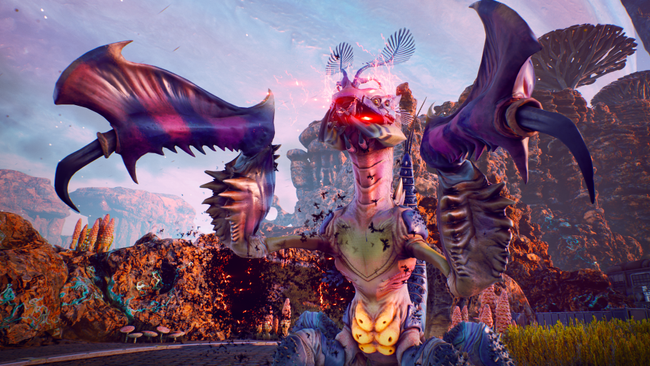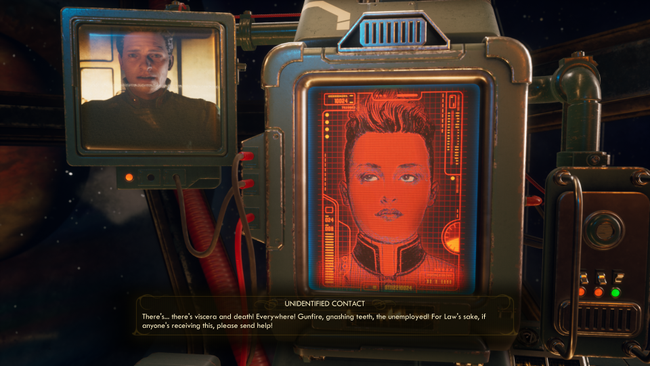
The Outer Worlds Hands-On Impressions
It’s not uncommon to see people claim that they preferred Obsidian’s Fallout: New Vegas over Bethesda Game Studio’s Fallout 3. Besides the fact that many of Fallout’s original creators went on to work at Obsidian, the fact remains that on its own merits Fallout: New Vegas is a much deeper RPG than Fallout 3, despite running on the same engine, and indeed, sharing a lot of the same DNA.
Last year, Obsidian announced The Outer Worlds, a title that has continued to draw endless comparisons to the company’s work on Fallout: New Vegas. Satirical, neo-retro designs and settings – a caricature of the past’s vision of the future. Proper dialog options, ability and stat trees, and so on. It’s easy to see why the title has inspired so much comparison, and it’s not like Obsidian have exactly hidden that inspiration either—indeed, from the very first reveal trailer “From the Developers Behind Fallout: New Vegas” was plastered front and center. But how far do those similarities run? Are they just aesthetic, or does the title manage to more closely emulate Fallout: New Vegas (and the titles before it) than Bethesda’s work on Fallout 4 and Fallout 76?
A few weeks ago, we got the chance to have several hours of hands-on time with the game during a preview event in Santa Monica, California. While we’re not allowed to share our time with the title’s opening moments—Obsidian were quick to state that they want the game’s beginning to be something special that each and every player experiences for themselves—we were indeed able to spend a good hour and a half playing a moment further into the story, getting a chance to explore various mechanics such as Time Dilation, the title’s focus on companion characters, as well as get our hands dirty with some sidequests.

The first thing I noticed upon loading into Monarch, one of the title’s main planets, was that Nyoka—one of the game’s companions—wished to enlist my help in a quest to bring herself some closure for her previous companions. Some of them she knows have died, while the whereabouts for the others are unknown. With little other direction, I elected to help her out, and off I went. Between finding the grave for one of her companions, infiltrating and rescuing an information broker from a radio tower, and discovering the last known whereabouts for a few more of her companions I wasn’t actually able to finish Nyoka’s request during my preview session.
Of course, companions having requests for the protagonist can only do so much for making these characters actually feel like trusted friends, or even actual characters of there own. One of the things that stood out to me throughout my time with the game was just how much dialog the game likes to use, even outside of dialog trees. Upon first discovering that aforementioned radio tower, Pavarti—a technician by trade—noted her curiosity about how they’d managed to get the radio signal out of the planet’s atmosphere. Upon requesting my help to clear out the tower, the broker that called the tower home helped point me to where the elevator was to go up as I ran around like a chicken with its head cut off, utterly blind to which direction was actually “up” in the tower, from a speaker in the corner of the room.
It’s the little things that really help you feel immersed in a game, and from where I’m standing The Outer Worlds definitely seems to have them in spades. The game has everything one would expect from the developers that made Fallout: New Vegas – proper dialog trees, multiple solutions for sidequests, and the sort of sardonic humor that many loved New Vegas for. Despite all of that, though, I think what shone through the most when playing the game was all the new additions to the formula that Obsidian has brought to the table. Perks are all absolutely bonkers upgrades for your character, and Obsidian know it. Periodically during your playthrough, depending on what you’ve done, you might discover a “flaw” in your character. Take too much damage to bugs? Congrats, you have yourself a phobia of them. Take a lot of fire damage? For some reason, you’re much more inflammable.

Taking these flaws is entirely optional, but in doing so not only do you gain a weakness, but also a perk point that can go towards greatly improving one of your character’s abilities. During our interview with Lead Designer Charles Staples, he likened this to one of the game’s philosophies of “choice and consequence”, and in action, it’s easy to see just how much more variety this one relatively small system can bring to the game, particularly on repeated playthroughs. I can’t say for sure if the game balance will be perfect just yet, but if nothing else the idea seems novel enough – and I’m eager to see how it works on a macro scale.
Probably the other major addition to the game’s DNA, compared to New Vegas, is the addition of various combat abilities. You can dodge attacks with a sidestep, you can slow down time to better aim with Time Dilation, you can order your partners to use specific attacks or skills. Ultimately, most of these systems aren’t strictly necessary—I didn’t actually notice the partner attack system until after my session, upon speaking with some other members of the press that did partake in it—but the point remains that it doesn’t take anything away from the experience, either. If you liked the idea of Obsidian’s Fallout: New Vegas in the past, but the combat didn’t interest you, maybe the combat here might be enough to tip those scales.
In all honesty, I haven’t had enough time with the game, nor a crystal ball, for me to be able to tell how the game will feel in the grand scheme of things. With that being said, it’s certainly off to a very good start. I feel pretty confident in saying that the game should at least be worth a look for anyone that has been a fan of New Vegas, or any of the other 3D Fallout titles. For now, the only real question mark on my mind is performance.

The build of the game that I played was running at 4K on a PC with a 2080 ti, an i7 7700k, a high-performance SSD, and 32GB of RAM. With maybe the exception of the rapidly aging 4 core/8 thread i7, the machine was definitely what you could call “top-of-the-line”, and at times the game absolutely struggled at the set resolution and graphics settings. In fairness, the game is in development, but the hitching that I experienced definitely felt very familiar to me – before my most recent PC upgrade I was also sporting a 4 core/8 thread CPU, and the sorts of stutter I felt during the demo definitely felt CPU related. If that’s the case, then even at 1080p those issues may have manifested. However, I wasn’t able to use any sort of overlay or have task manager open to directly check performance metrics, so these are just guesses. In all likelihood, the final product will run smoother, but at times the hitching was bad enough that it was really hard to ignore, and the game is only a few months away from release.
Obsidian has something special on their hands, here. While I’m cautious to make any sort of sweeping statements from 2 hours of play for an RPG that aims to be dozens of hours long, if the game’s quality manages to stay consistent throughout the rest of the experience, RPG fans are going to be in for a treat when the game launches later this year.
As an aside, a few months back another staff writer - Bryan - also got the chance to play through a bit of The Outer Worlds. If you haven't already, you can read his own impressions on the title.